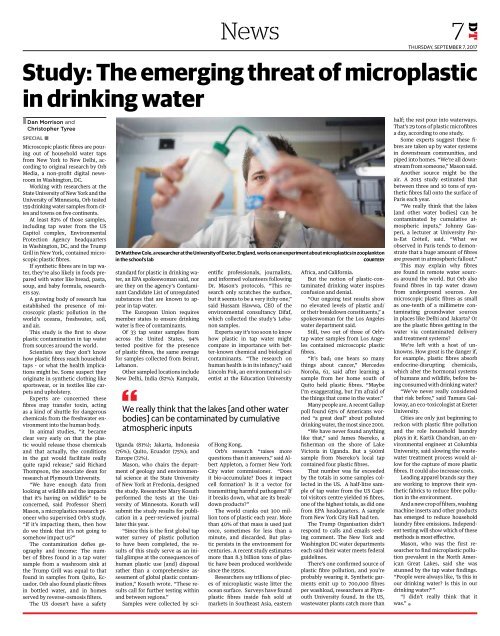e_Paper, Thursday, September 7, 2017
You also want an ePaper? Increase the reach of your titles
YUMPU automatically turns print PDFs into web optimized ePapers that Google loves.
News<br />
THURSDAY,<br />
7<br />
SEPTEMBER 7, <strong>2017</strong><br />
DT<br />
Study: The emerging threat of microplastic<br />
in drinking water<br />
• Dan Morrison and<br />
Christopher Tyree<br />
SPECIAL <br />
Microscopic plastic fibres are pouring<br />
out of household water taps<br />
from New York to New Delhi, according<br />
to original research by Orb<br />
Media, a non-profit digital newsroom<br />
in Washington, DC.<br />
Working with researchers at the<br />
State University of New York and the<br />
University of Minnesota, Orb tested<br />
159 drinking water samples from cities<br />
and towns on five continents.<br />
At least 83% of those samples,<br />
including tap water from the US<br />
Capitol complex, Environmental<br />
Protection Agency headquarters<br />
in Washington, DC, and the Trump<br />
Grill in New York, contained microscopic<br />
plastic fibres.<br />
If synthetic fibres are in tap water,<br />
they’re also likely in foods prepared<br />
with water like bread, pasta,<br />
soup, and baby formula, researchers<br />
say.<br />
A growing body of research has<br />
established the presence of microscopic<br />
plastic pollution in the<br />
world’s oceans, freshwater, soil,<br />
and air.<br />
This study is the first to show<br />
plastic contamination in tap water<br />
from sources around the world.<br />
Scientists say they don’t know<br />
how plastic fibres reach household<br />
taps – or what the health implications<br />
might be. Some suspect they<br />
originate in synthetic clothing like<br />
sportswear, or in textiles like carpets<br />
and upholstery.<br />
Experts are concerned these<br />
fibres may transfer toxin, acting<br />
as a kind of shuttle for dangerous<br />
chemicals from the freshwater environment<br />
into the human body.<br />
In animal studies, “it became<br />
clear very early on that the plastic<br />
would release those chemicals<br />
and that actually, the conditions<br />
in the gut would facilitate really<br />
quite rapid release,” said Richard<br />
Thompson, the associate dean for<br />
research at Plymouth University.<br />
“We have enough data from<br />
looking at wildlife and the impacts<br />
that it’s having on wildlife” to be<br />
concerned, said Professor Sherri<br />
Mason, a microplastics research pioneer<br />
who supervised Orb’s study.<br />
“If it’s impacting them, then how<br />
do we think that it’s not going to<br />
somehow impact us?”<br />
The contamination defies geography<br />
and income: The number<br />
of fibres found in a tap water<br />
sample from a washroom sink at<br />
the Trump Grill was equal to that<br />
found in samples from Quito, Ecuador.<br />
Orb also found plastic fibres<br />
in bottled water, and in homes<br />
served by reverse-osmosis filters.<br />
The US doesn’t have a safety<br />
Dr Matthew Cole, a researcher at the University of Exeter, England, works on an experiment about microplastics in zooplankton<br />
in the school’s lab<br />
COURTESY<br />
standard for plastic in drinking water,<br />
an EPA spokeswoman said, nor<br />
are they on the agency’s Contaminant<br />
Candidate List of unregulated<br />
substances that are known to appear<br />
in tap water.<br />
The European Union requires<br />
member states to ensure drinking<br />
water is free of contaminants.<br />
Of 33 tap water samples from<br />
across the United States, 94%<br />
tested positive for the presence<br />
of plastic fibres, the same average<br />
for samples collected from Beirut,<br />
Lebanon.<br />
Other sampled locations include<br />
New Delhi, India (82%); Kampala,<br />
Uganda (81%); Jakarta, Indonesia<br />
(76%); Quito, Ecuador (75%); and<br />
Europe (72%).<br />
Mason, who chairs the department<br />
of geology and environmental<br />
science at the State University<br />
of New York at Fredonia, designed<br />
the study. Researcher Mary Kosuth<br />
performed the tests at the University<br />
of Minnesota. Kosuth will<br />
submit the study results for publication<br />
in a peer-reviewed journal<br />
later this year.<br />
“Since this is the first global tap<br />
water survey of plastic pollution<br />
to have been completed, the results<br />
of this study serve as an initial<br />
glimpse at the consequences of<br />
human plastic use [and] disposal<br />
rather than a comprehensive assessment<br />
of global plastic contamination,”<br />
Kosuth wrote. “These results<br />
call for further testing within<br />
and between regions.”<br />
Samples were collected by scientific<br />
professionals, journalists,<br />
and informed volunteers following<br />
Dr. Mason’s protocols. “This research<br />
only scratches the surface,<br />
but it seems to be a very itchy one,”<br />
said Hussam Hawwa, CEO of the<br />
environmental consultancy Difaf,<br />
which collected the study’s Lebanon<br />
samples.<br />
Experts say it’s too soon to know<br />
how plastic in tap water might<br />
compare in importance with better-known<br />
chemical and biological<br />
contaminants. “The research on<br />
human health is in its infancy,” said<br />
Lincoln Fok, an environmental scientist<br />
at the Education University<br />
We really think that the lakes [and other water<br />
bodies] can be contaminated by cumulative<br />
atmospheric inputs<br />
of Hong Kong.<br />
Orb’s research “raises more<br />
questions than it answers,” said Albert<br />
Appleton, a former New York<br />
City water commissioner. “Does<br />
it bio-accumulate? Does it impact<br />
cell formation? Is it a vector for<br />
transmitting harmful pathogens? If<br />
it breaks down, what are its breakdown<br />
products?”<br />
The world cranks out 300 million<br />
tons of plastic each year. More<br />
than 40% of that mass is used just<br />
once, sometimes for less than a<br />
minute, and discarded. But plastic<br />
persists in the environment for<br />
centuries. A recent study estimates<br />
more than 8.3 billion tons of plastic<br />
have been produced worldwide<br />
since the 1950s.<br />
Researchers say trillions of pieces<br />
of microplastic waste litter the<br />
ocean surface. Surveys have found<br />
plastic fibres inside fish sold at<br />
markets in Southeast Asia, eastern<br />
Africa, and California.<br />
But the notion of plastic-contaminated<br />
drinking water inspires<br />
confusion and denial.<br />
“Our ongoing test results show<br />
no elevated levels of plastic and/<br />
or their breakdown constituents,” a<br />
spokeswoman for the Los Angeles<br />
water department said.<br />
Still, two out of three of Orb’s<br />
tap water samples from Los Angeles<br />
contained microscopic plastic<br />
fibres.<br />
“It’s bad; one hears so many<br />
things about cancer,” Mercedes<br />
Noroña, 61, said after learning a<br />
sample from her home south of<br />
Quito held plastic fibres. “Maybe<br />
I’m exaggerating, but I’m afraid of<br />
the things that come in the water.”<br />
Many people are. A recent Gallup<br />
poll found 63% of Americans worried<br />
“a great deal” about polluted<br />
drinking water, the most since 2001.<br />
“We have never found anything<br />
like that,” said James Nsereko, a<br />
fisherman on the shore of Lake<br />
Victoria in Uganda. But a 500ml<br />
sample from Nsereko’s local tap<br />
contained four plastic fibres.<br />
That number was far exceeded<br />
by the totals in some samples collected<br />
in the US. A half-litre sample<br />
of tap water from the US Capitol<br />
visitors centre yielded 16 fibres,<br />
one of the highest totals, as did one<br />
from EPA headquarters. A sample<br />
from New York City Hall had ten.<br />
The Trump Organisation didn’t<br />
respond to calls and emails seeking<br />
comment. The New York and<br />
Washington DC water departments<br />
each said their water meets federal<br />
guidelines.<br />
There’s one confirmed source of<br />
plastic fibre pollution, and you’re<br />
probably wearing it. Synthetic garments<br />
emit up to 700,000 fibres<br />
per washload, researchers at Plymouth<br />
University found. In the US,<br />
wastewater plants catch more than<br />
half; the rest pour into waterways.<br />
That’s 29 tons of plastic microfibres<br />
a day, according to one study.<br />
Some experts suggest these fibres<br />
are taken up by water systems<br />
in downstream communities, and<br />
piped into homes. “We’re all downstream<br />
from someone,” Mason said.<br />
Another source might be the<br />
air. A 2015 study estimated that<br />
between three and 10 tons of synthetic<br />
fibres fall onto the surface of<br />
Paris each year.<br />
“We really think that the lakes<br />
[and other water bodies] can be<br />
contaminated by cumulative atmospheric<br />
inputs,” Johnny Gasperi,<br />
a lecturer at University Paris-Est<br />
Créteil, said. “What we<br />
observed in Paris tends to demonstrate<br />
that a huge amount of fibres<br />
are present in atmospheric fallout.”<br />
This may explain why fibres<br />
are found in remote water sources<br />
around the world. But Orb also<br />
found fibres in tap water drawn<br />
from underground sources. Are<br />
microscopic plastic fibres as small<br />
as one-tenth of a millimetre contaminating<br />
groundwater sources<br />
in places like Delhi and Jakarta? Or<br />
are the plastic fibres getting in the<br />
water via contaminated delivery<br />
and treatment systems?<br />
We’re left with a host of unknowns.<br />
How great is the danger if,<br />
for example, plastic fibres absorb<br />
endocrine-disrupting chemicals,<br />
which alter the hormonal systems<br />
of humans and wildlife, before being<br />
consumed with drinking water?<br />
“We’ve never really considered<br />
that risk before,” said Tamara Galloway,<br />
an eco-toxicologist at Exeter<br />
University.<br />
Cities are only just beginning to<br />
reckon with plastic fibre pollution<br />
and the role household laundry<br />
plays in it. Kartik Chandran, an environmental<br />
engineer at Columbia<br />
University, said slowing the wastewater<br />
treatment process would allow<br />
for the capture of more plastic<br />
fibres. It could also increase costs.<br />
Leading apparel brands say they<br />
are working to improve their synthetic<br />
fabrics to reduce fibre pollution<br />
in the environment.<br />
And a new crop of filters, washing<br />
machine inserts and other products<br />
has emerged to reduce household<br />
laundry fibre emissions. Independent<br />
testing will show which of these<br />
methods is most effective.<br />
Mason, who was the first researcher<br />
to find microplastic pollution<br />
prevalent in the North American<br />
Great Lakes, said she was<br />
stunned by the tap water findings.<br />
“People were always like, ‘Is this in<br />
our drinking water? Is this in our<br />
drinking water?’”<br />
“I didn’t really think that it<br />
was.” •

















